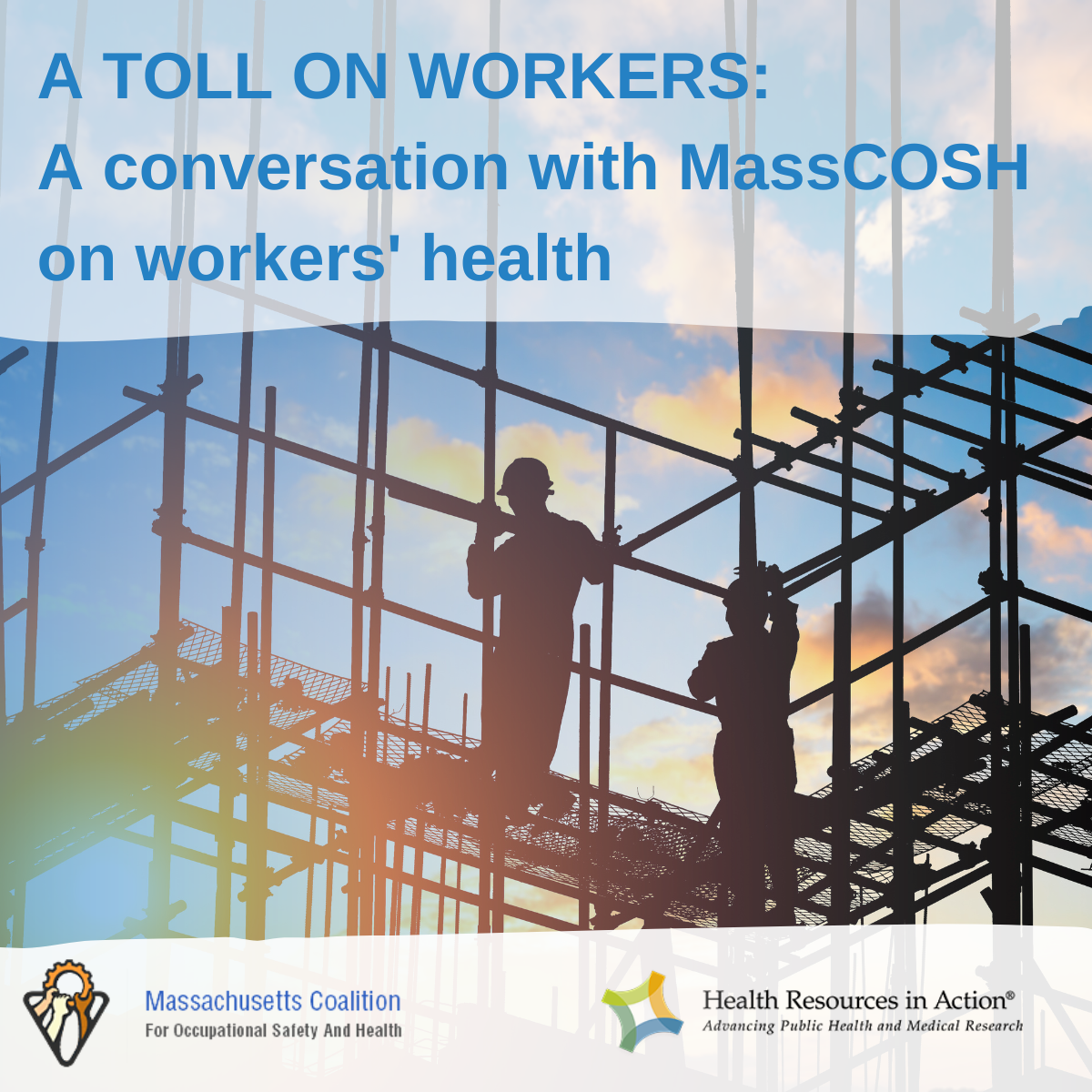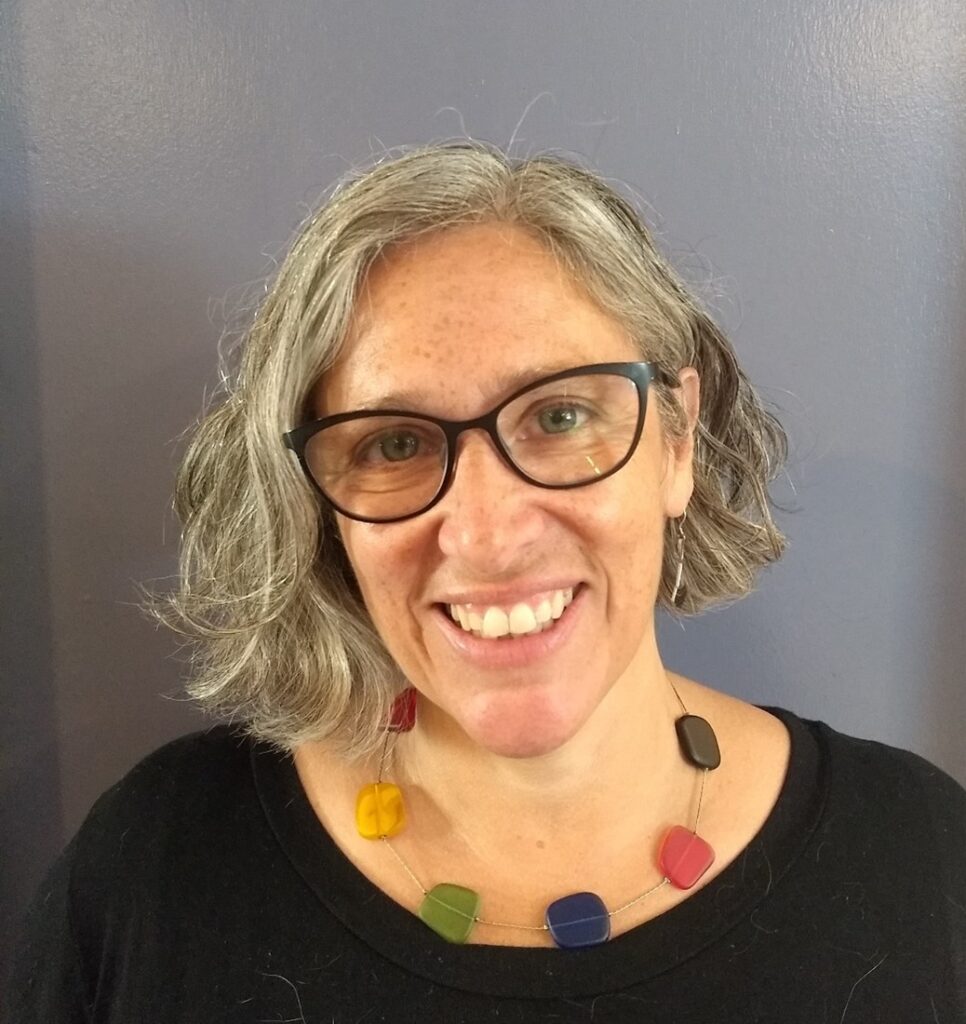
Since 2001, August 31st has marked International Opioid Awareness Day, or IOAD, which kicks off September’s Recovery Month. In recognition of both IOAD and Recovery Month, HRiA’s Geri Medina spoke with Jodi Sugerman-Brozan, outgoing Executive Director of MassCOSH and soon-to-be Deputy Chief for the first-ever Cabinet of Worker Empowerment in the City of Boston, to discuss the organization’s work on opioid use and the workplace, and how this crisis has been impacted by the COVID-19 pandemic. MassCOSH is a leader in workplace health and safety and longtime partner of HRiA through the BeHERE initiative and the COVID-19 Community Grants program. The following is a lightly edited transcript of their conversation.

Geri: Tell us about MassCOSH and your role there.
Jodi: My name is Jodi Sugerman-Brozan, and I’m executive director of the Massachusetts Coalition for Occupational Safety and Health (MassCOSH). In that role, I oversee all aspects of our work around worker health and safety, including our work focused on opioids in the workplace.
Geri: Why is MassCOSH interested in opioid use in the workplace?
Jodi: Our work started with a report that we publish annually, called “Dying for Work,” which collects data on workplace fatalities. The purpose of the report is to really understand what is killing workers who are dying while on the job, in what industries etc., so that we can ensure that we are putting resources where they’re most needed to protect workers from work-related fatalities.
For years, we received data on overdose on the job and suicide on the job, but the data was always negligible. And then, in 2016, and 2017, we started to see a huge jump from up to 5 overdoses per year, to over 40 overdoses on the job per year–these were individuals who literally overdosed while at work. We decided that these were numbers that we could not ignore. So, we published the data in our 2018 report for the first time, in addition to recognizing and honoring the families of the workers who passed away. We wanted those families to know that we saw them, that we were mourning with them, and that we were going to do something about this.

Geri: Was this issue being recognized on a bigger scale at the time?
Jodi: Yes, in fact, at the same time, The Massachusetts Department of Public Health was also noticing these overdose trends. They published a groundbreaking report in which they looked back at the occupational industries of those who died from 2011-2015. What they found was what we suspected; that workers who are more susceptible to workplace injury are more likely to experience opioid overdose and were dying at higher rates overall. Additionally, workers with less access to paid time off to recover from injuries were dying at higher rates.
As a result of the groundbreaking report, the Massachusetts Department of Public Health began to look at how we could address both work-related injury and pain through a prevention. And it’s important to think about both workplace injury and pain, because a lot of times when you talk to workers who are on opioid painkillers, it’s not because they’ve been injured, it’s because the work that they do causes chronic pain. And in order to be able to keep their jobs, they need to take these medications because many of them don’t have access to paid time off. This was also an issue we saw during the COVID-19 pandemic.
We wanted those families to know that we saw them, that we were mourning with them, and that we were going to do something about this.
Jodi Sugerman-Brozan
Geri: Can you tell us more about what you are seeing at the intersection of opioid use, the workplace, and COVID-19?
Jodi: Throughout both crises, we have observed the same issues; workers are overwhelmed and dealing with anxiety, pay issues, and lack of benefits like paid sick time. Therefore, it’s not surprising that these same industries impacted by opioid overdose are also dealing with COVID-19 impacts. Throughout the pandemic, workers have died from COVID-19, other workers are quitting, developing long-COVID, and dealing with understaffing, which puts a toll on workers’ bodies, and can lead them to opioid use to manage that toll.
It’s also evident in the data. According to the Massachusetts Department of Public Health, some of the hardest hit industries for opioid use have also been the hardest hit for COVID-19. You see overlap in the demographics as well; people of color have been hard hit by both crises. The demographic data on overdose deaths initially was not so striking; however, from 2018-2020, it’s very alarming. More people of color, especially Black men, are dying from opioid overdose, including here in Massachusetts. We need to take a close look at increases in people of color (POC) overdose to understand why and mitigate these deaths. In order to do so, we need specific strategies to reach these communities.
Geri: How is MassCOSH addressing these intersecting crises?
Jodi: To begin to address these concerns, we did a pilot project in which we partnered with three different unions in those industries that were high hit by workplace injury and overdose fatalities: construction, iron workers, and transportation. From the public health data and our pilot findings, as much as work can be a pathway to overdose, we also believe that work can be a pathway to recovery.
We partnered with the unions to conduct peer-led training on opioids, the connection between workplace pain and opioids, and ways that we could have peer-led, prevention approaches. We thought we would see the same results across all three unions, but what we found out initially was that every industry has its own approach to peer-led trainings. What the nurses needed was completely different from what iron workers needed, etc. And each of these pilots led to some long-term projects. Now, there’s the iron workers who conduct opioid awareness training as part of their apprenticeship program every onboarding. There’s also a peer leadership program within the Teamsters (transportation union) to support peer-led support around recovery from substance use.
We have also been an advisor to the BeHERE initiative through Health Resources in Action, helping to create a program of trainings and resources on workplace safety, injury, and opioid use.
On a policy level, we are continuing to advocate for paid time off, which is so critical, especially for COVID-19, and for workers with injury. We also advocate for worker’s comp for COVID, especially in the context of workers who develop long-COVID, and for accommodations when workers return to work.
Some of the hardest hit industries for opioid use have also been the hardest hit for COVID-19.
Jodi Sugerman-Brozan
There is an advisory board that is working on deciding how to use funds and resources from state lawsuits won against pharmaceutical companies; we are advocating for workplace focused approaches that will fund prevention-based strategies to address overdose in the workplace.
Finally, our core work is grounded in protecting workers’ health and safety. We train hundreds of workers, employers as well, every year, in multiple languages and formats, on COVID-19, preventing workplace injury, and the connections between pain and opioid use, and how workers can advocate for more protections.
Geri: What are the opportunities you see for others to support this work?
Jodi: It’s important for workers and employers to first understand the connection between workplace injury and opioid use, and that they can play a role in preventing opioid overdose. We strongly use this framework– that workplace injuries and overdose deaths are not accidents- they can be prevented.
There also needs to be funding for prevention-based approaches and advocacy for alternative pain pathways. Using additional funding from the state from opioid case settlements toward prevention-based approaches is one way this could happen.
We’re excited to see the Occupational Health and Safety (OSHA) recognize this issue and they’re currently working on OSHA 10 modules on workplace injury, pain, and opioids use. From the initial data we are seeing, additional research into the demographics of this issue is also needed to understand why certain communities are more vulnerable to overdose deaths, so that we can begin to reach these communities and tailor approaches specifically to their needs.
In order to be able to keep their jobs, [workers] need to take these medications because many of them don’t have access to paid time off.
Jodi Sugerman-Brozan
In terms of advocacy, worker’s rights as they relate to COVID-19 are needed. Ensuring that if workers have COVID-19 symptoms, or suspect they have COVID-19, they have the means and access to paid time off to stay home, which are benefits that not all workers have.
Want to learn more?
MassCOSH continues to offer health and safety training to workers on a variety of issues including opioids and work. They also continue to advocate for policies and programs to prevent workplace injury and pain that can be a pathway to opioid addiction and overdose and for recovery supportive workplaces. For more information on their work and programs go to www.masscosh.org and read their latest Dying for Work in Massachusetts.

